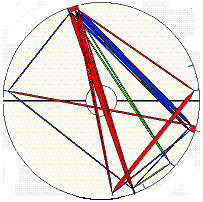The Planetary Aspects in Astrology
The colored lines we see in the circle of an astrology chart or birth chart are called planetary aspects. They are the geometric angles the planets make to one another or to a sensitive point in the chart such as the Ascendant or Midheaven. The aspects will affect how a planet is expressed. They tell you how the planets relate to each other in your chart. Suggestion: To learn the planetary aspects its highly recommended that you put all the aspect symbols and their meaning to memory. Print out this page and make flash cards. Practice drawing each symbol until it becomes second nature. Major Aspects
Conjunction Angle (0 degrees) allowed orb (8 degrees) The Conjunction emphasises the energy from two planets or from a planet and point. Blend the two planets together and you have a powerful force that can be either positive or negative depending on how its energy is used. 
Opposition Angle (180 degrees) allowed orb (7 or 8 degrees) The Opposition aspect brings a sense of awareness to the individual. Depending on the planets involved it may show an aptitude for seeing both sides of any given situation. On the negative side, its also thought to bring stress from two opposing forces. 
Square Angle (90 degrees) allowed orb (6 or 7 degrees) The Square is another powerful planetary aspect. Its energy is challenging; however, if the challenge is overcome, the end result can be very advantageous. 
Trine - Angle (120 degrees) - allowed orb (6 or 7 degrees) The Trine is considered an easy and harmonious aspect. It reveals natural abilities and prospects that can be utilized by an individual with sufficient motivation. 
Sextile Angle (60 degrees) allowed orb (5 degrees) This is a beneficial aspect and usually represents opportunities and skills that can be capitalized on. 
Inconjunct (Quincunx) Angle (150 degrees) allowed orb (5 degrees) The Inconjunct was once considered a minor aspect but has since been revaluated. Like the Square, the Inconjunct is challenging in nature and is often related to adjustments required by an individual. Although difficult, this aspect can prove most favorable if the adjustments are made successfully. Minor AspectsThere are numerous minor planetary aspects. To keep things simple only the 3 most commonly used have been listed. 
Semi-Sextile Angle (30 degrees) Allowed orb (1 or 2 degrees) The Semi-sextile reveals unseen opportunity. The type of opportunity will depend on the Planets involved and the Signs and houses they are positioned in. 
Semi-square Angle (45 degrees) Allowed orb (1 or 2 degrees) A Semi-square has an irritating quality about it. It reveals an area that requires a change in attitude in order to move forward. 
Sesqui-square Angle (135 degrees) Allowed orb (1 or 2 degrees) The Sesqui-square is considered abrasive in nature. It will show an area of irritation or dissatisfaction. Retrograde - This is not an aspect but rather a planetary motion which affects the aspects involved. Retrograde motion is when a planet appears to be moving backward. In actuality, the planets speed slows down giving the illusion that it is travelling backward.A retrograde planet in the birth chart reveals situations in life that will appear or develop later in time rather than earlier. Once you have become familiar with each planetary aspect and have memorized the glyphs (symbols) that go with it you are ready to take the next step. Return from Planetary Aspects back to Learn Astrology-Step 8 Or
|
||||||||||||
Would you prefer to share this page with others by linking to it?